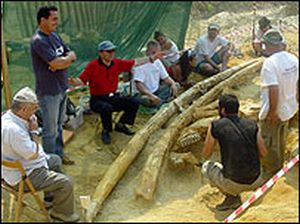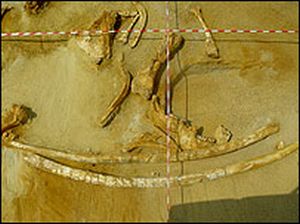tags: mastodon fossils, Greece
AMNH 9951, skeleton of the American mastodont, Mammut americanum, Newburgh, NY.
Image: AMNH (American Museum of Natural History, NYC, NY) [larger]
In an astonishing discovery, a three million year old "fossilized zoo" was discovered by Greek geologists yesterday in the northern Milia region near the town of Grevena. This "zoo" contains the fossilized remains of prehistoric rhinos, mastodons, gazelles and carnivorous mammals.
 The discovery included a pair of tusks from a mastodon (pictured left. Image: Evangelia Tsoukala), an ancient species of elephant that lived three million years ago, before modern elephants appeared. The tusks, which weigh one ton each and are mostly intact, are 5 meters (16.5 feet) and 4 meters (14 feet) long, and are thought to be the longest ever found.
The discovery included a pair of tusks from a mastodon (pictured left. Image: Evangelia Tsoukala), an ancient species of elephant that lived three million years ago, before modern elephants appeared. The tusks, which weigh one ton each and are mostly intact, are 5 meters (16.5 feet) and 4 meters (14 feet) long, and are thought to be the longest ever found.
"We have contacted the Guinness Book of Records, and are expecting an answer by the end of summer. We are confident that the Grevena mastodon will occupy the place is deserves in the book of records," said Evangelia Tsoukala, a professor of geology from the Aristotle University of Thessaloniki. Tsoukala heads a team of Greek and Dutch experts along with Dutch specialists from the Natural History Museum in Rotterdam, who have been working in the Grevena region for the past 10 years.
The team plans to compare their mastodon fossils with those found in the Americas. For example, the largest fossilized tusks ever discovered in the Americas are probably 3.9 metres (12.8 feet) long.
 The team also dug up a fossilized humerus, the long bone of the arm that reaches from the shoulder to the elbow, along with thigh bones and some teeth believed to have belonged to the same animal (pictured right. Image: Evangelia Tsoukala). The mastodon, believed to have been a male that was approximately 25 years old, was 3.5 meters tall and weighed over 6 tons, according to experts.
The team also dug up a fossilized humerus, the long bone of the arm that reaches from the shoulder to the elbow, along with thigh bones and some teeth believed to have belonged to the same animal (pictured right. Image: Evangelia Tsoukala). The mastodon, believed to have been a male that was approximately 25 years old, was 3.5 meters tall and weighed over 6 tons, according to experts.
"This is a rare and unique find in Greece, and is useful for studies of a period dating back three million years," explained Tsoukala.
The same team discovered another pair of mastodon tusks, measuring 4.38 meters, in 1998. Other European mastodon fossils have been previously discovered in England, Germany and the Netherlands.
Mastodons, like their extinct cousins, woolly mammoths, and the still-living modern-day elephants, are all classified into the taxonomic order, Proboscidea. While superficially similar to their cousins, the woolly mammoths, the mastodon's tusks pointed forward rather than curling upwards as mammoths' did, and mastodons fed on leaves, instead of grazing. Thus, the two extinct species' teeth were also different. Mastodons probably first appeared around five million years ago, and became extinct in Europe between two and three million years ago. The mastodon eventually also disappeared from North America between 9,000 and 12,000 years ago.
The team hopes that some of the animal's DNA can be recovered from the tusks. Scientists will study the bones at a research center in the Milia region of northern Greece, and eventually these fossils will be displayed at a Museum in Milia.
Sources
Kathimerini (quote).
BBC News (quotes).


Seems to be a good day for trunked beasties: this paper also came out. The BBC had a good article on it: I'll blog about it tomorrow, once I've found a paper on testicondy.
Bob
It's amazing how much the fossils of Greece and surrounding areas probably contributed to myths about gods and heroes. If you haven't already check out Adrienne Mayor's The First Fossil Hunters. She provides a good summary of how finds like this one correlate to Greek mythology.